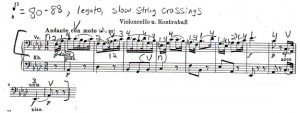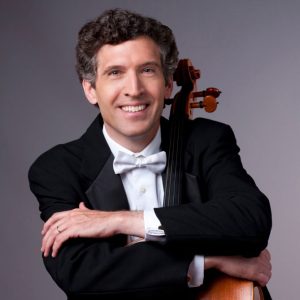
Exploring Beethoven’s Fifth Symphony
Jonathan Pegis
Here in just a few measures is an excerpt that has confused, befuddled, and downright scared more cellists than just about any other excerpt (please click image to enlarge):
The theme from the second movement of Beethoven’s fifth, along with the first two variations, shows up on the vast majority of cello audition lists. I thought it would be educational to spend some time exploring this theme, and future blogs will explore the first and second variations. To begin with, this excerpt is one of a handful that I have coached for many years where I am actually LESS confident than I used to be. Why? Because every teacher, every coach, and every conductor has had radically different ideas about all the different aspects of this theme. Temp, color, dynamic, and phrasing are all up for grabs in this excerpt. If you think about the opening of Don Juan, yes I admit it’s very difficult but there is very little variation in the way it is played from one orchestra to another. This theme, however, can be played convincingly in many different ways. But first, let us look at the main technical difficulty, which is playing a legato, dotted rhythm.
The dotted rhythms throughout this theme are closely related to your tempo, with a slower tempo resulting in a broader 32nd note and vice versa at a faster tempo. When I was actively auditioning I played this excerpt very close to the metronome marking of 92, but since then I have slowed it down closer to 80 or 84. Do remember that it is marked Andante, not Adagio! But whatever tempo you play the dotted rhythms must be precise, regardless of whether or not there is a string crossing involved. I am well aware that there is a commercially available CD of orchestral excerpts where the narrator recommends playing the dotted rhythms “between a triplet and a 32nd note” but I have to say that I think this is bad advice. Every committee I have served on always counts the rhythm as you are playing it. There are two common mistakes in this theme. The first is what I call the “beautiful triplets” where the dotted rhythms really are triplets which makes the excerpt a lot easier in many ways. The second is the “march” where the rhythm is actually closer to double-dotted and the phrasing becomes rather clipped. The technical “solution” for this excerpt results in both hands doing completely different things. The right hand must never slow down or pause between the dotted 16ths and the 32nds, and the left hand must maintain the correct rhythm while sustaining a gentle vibrato. Avoid another pitfall which is where the 16ths are really “juiced” with vibrato while the 32nds have none. I should mention that it is difficult to think about all these things while you are playing the excerpt, so I highly recommend recording yourself when you are preparing this for an audition. I first started recording myself when I was a grad student studying with Paul, and it was a real shock to realize that I had no idea what I sounded like when I was practicing. Of course, way back then it was a lot harder to get decent recording equipment than it is today! But that subject could be a whole different blog…..
Let’s look at some of the musical challenges of this theme. Let me mention that it is quite common to worry about what the committee is thinking while you are playing this, and in our fear of making a mistake we end up not phrasing at all! Look at the first 3 notes: it is usually played as a pickup leading into the downbeat and yet there are a few conductors (like Sir Georg Solti) who actually liked us to start a bit more on the first note and release into the downbeat. So I always tell my students that you can shape it either way, but make sure the committee can tell how you are hearing the phrase. Personally I liked Sir Georg’s phrasing but I would probably play it as a pickup in an audition. I should also mention that many orchestras change bows on the downbeat, but for auditioning I think one down bow is better since it is more legato and avoids an unnecessary accent on the downbeat.
One of the biggest challenge with this excerpt is the dynamic/color question. It is marked p, not pp, AND it is the theme. So a “singing piano” is most often recommended for this excerpt. How do we achieve this? Well, I am going to repeat the advice that I got years ago from Steve Doane which was to NOT use flotando for this excerpt. Rather, use the same light pressure in the right hand that you would use for flotando and then start slowing the bow down. If you add more pressure you will find yourself getting too loud, but if you just slow the bow speed down a bit at some point you will find a slightly fuller, but piano tone. Another advantage of this more focused sound is that it will help the committee to hear if your rhythm is really accurate. Once you have the tone, you need to think about the shape of the phrase. Looking at the bass line it seems to lead to the downbeat of measure 4 so we want to make a slight crescendo in measure 3. I do this measure on one down bow, but at a slower tempo this is not enough bow so you must change bows without losing the line or accenting the bow change. I should also mention that just because there is no crescendo marked does not mean that you should not play with any shape at all. As long as you “lead” to the 4th measure without going above your singing piano sound you are simply adding some inflection (much like speaking) so the listener can tell where you are going with the phrase. This is another example of how our fear of offending the committee can lead to a kind of musical paralysis.
What happens after measure 4? Many orchestras initially taper off in this measure and then lead into the downbeat of measure 6. I don’t like to do this for 2 reasons. First, I believe that a simple arch phrase is better and more natural musically. Second, for purely pragmatic reasons I want to be quite soft in measure 6 so I can better prepare the subito forte in measure 7. This, by the way, IS a true Beethoven subito forte, so do not make any crescendo on the pickup. If you need to do a slight re-take between the two A flats that is fine since you must take a musical (and hopefully physical!) breath between these two notes. Once you arrive on the downbeat of the 7th measure sustain all the way to the end of the measure without any diminuendo. I actually try to make a tiny crescendo on the long E flat just to make sure I don’t taper off at all. The same is true for the pickup into measure 9; no crescendo on the pickup and sustain the low E flat to the end of the measure. Also, remember that measure 7 and 9 are two different registers so we will want to use a slightly slower, wider vibrato on measure 9. Why? Because we are in the bass register of the human voice so we can’t use a mezzo-soprano vibrato here. If we do it will just sound nervous instead of full and relaxed. I used to practice the low E flat with a slightly slower vibrato than I really wanted because I knew that audition nerves would speed things up. Sometimes a lot!
As you can see, this theme is anything but simple! Make sure you have a good coach to play this for since there are so many technical and musical challenges in this excerpt. My next blog will explore the many difficulties of the first variation.
Subjects: Orchestra, Repertoire
Tags: accents, Audition, Beethoven, blog, bow changes, bow speed, cello, cellobello, coaching, confidence, control, dynamics, education, Excerpts, inflection, legato, markings, mistakes, nerves, orchestra, orchestral excerpts, phrasing, practicing, Preparation, pressure, recording, release, Rhythm, singing, sustain, Symphony, teacher, Teaching, technical challenges, variations, vibrato

